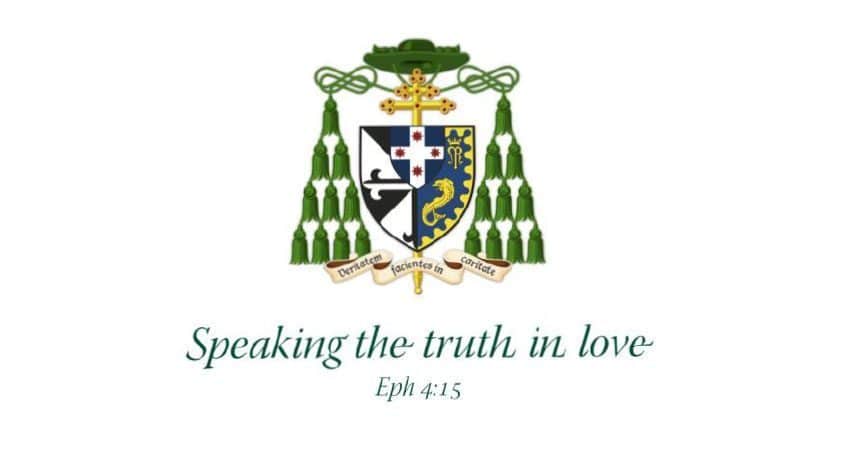HOMILY FOR MASS FOR 2ND SUNDAY IN LENT YEAR C

OPENING OF CATHOLIC INSTITUTE OF SYDNEY ACADEMIC YEAR
St. Mary’s Cathedral, Sydney, 13 March 2022
Late last year Netflix aired a documentary, 14 Peaks: Nothing is Impossible, that told the story of Nirmal Purja, known to his friends as ‘Nims’.[i] A former Gurkha turned mountaineer, on 23 April 2019 he climbed Annapurna, the deadliest mountain in the world.[ii] It was the beginning of an audacious plan Nims dubbed ‘Project Possible’: to join the handful of those who have scaled all fourteen of the world’s 8000m+ mountains, but to do so in a matter of months rather than over the many years it had taken all the others.[iii] Along the way Nims rescued several distressed climbers facing almost certain death, thereby setting back his chances of achieving his goal in the narrow window weather allowed. Yet 189 days later, he summited the last mountain on his list, Tibet’s Shishapangma. It is an incredible story of human triumph over the seemingly impossible.
Mountains have always had their allure. When George Mallory set out in 1924 on his doomed mission to climb Mount Everest, he famously explained he did so “Because it’s there.” When Edmund Hilary and Tenzing Norgay succeeded in 1953, they found no trace of Mallory’s long lost party, but marked their own achievement by leaving a crucifix and food offering before descending the mountain. Nowadays hundreds of would-be conquerors line up shoulder-to-shoulder during the open season, hoping to push their limits and achieve something with major bragging rights. How many plan to leave some token of thanks to God I’m not sure. But it’s clear that some, at least, are looking for more than fame: they are seeking the serene, the sublime, the transcendent from ‘the top of the world’. The Orthodox theologian Sergius Bulgakov said that one of the things that brought him back to Christianity from atheistic Marxism was seeing the splendour of the Caucuses.[iv] Catholics also have a fondness for high places: just look at how many of our churches are on hills and of our monasteries on the most inaccessible cliffs.
God has a knack for making Himself known in such places. Following the great flood, Noah’s Ark came to rest on Mt Ararat and there humanity received the promise of God’s protection (Gen 8:4). To seal the covenant, God sent Abraham to sacrifice on Mt Moriah (Gen 22:2-3,14). Moses first encountered God on Horeb (Ex 3:1; cf 4:27), received the Law atop Sinai (Ex chs 19, 2, 31 and 34) and saw the promised land from Mt Nebo (Dt 34:1-4; Num 27:12). Elijah, too, was instructed on Horeb (1Kings 19:11-17). And David built his capital Jerusalem on Mt Sion (2 Sam 5:7; 1Kings 8:1; 1Chr 11:5; 2Chr 5:2), which the Psalms and Prophets celebrated as ‘the holy mountain’ or ‘the mountain of the Lord’.[v]
Jesus, too, could play mountaineer. He liked to pray in high places;[vi] they were the backdrop for his most famous teachings and miracles;[vii] and also where He appointed and conversed with the Twelve (Mt 24:3; Mk 3:13; 13:3; Lk 6:12). The Mountains of Olives and Calvary were the sites of His Palm Sunday entry, Holy Thursday agony, Good Friday crucifixion and ultimate ascension.[viii]
Last week we saw Him taken up a mountain by Satan to be tempted by the splendour of the nations (Lk 4:5; Mt 4:8). In Part II, as it were, we see him today, back up a mountain showing the devil and all of us also just who He is. On Tabor He reveals His glory is sound and light much as the Father had done in the theophanies to Moses (Lk 9:28-36; cf. Mt 17:1,9; Mk 9:2,9). We can only imagine the astonishment the three disciples experienced as they watched Jesus turn to light, heard God’s voice and saw his sherpas Moses and Elijah. The representatives of the Law and Prophets are eclipsed by the Beloved Son, Light from Light, True God from True God.
But Jesus isn’t showing off; when He climbs mountains it’s not for bragging rights. No, He lets us glimpse His divine spendour to prepare us for His Passion and glory to come, and to promise us a share in this, if we will take up our cross and follow (Lk 9:23). For we too will “become partakers of the divine nature” (2 Pet 1:4), we too will “become like Him” (1Jn 3:2; cf. 1:5-7) , we too will be glorified in light (cf. Phil 3:21). St Athanasius made the point beautifully if provocatively when he said “God became man so that we might become God.”[ix] Or as Aquinas, put it, in God’s exitus and reditus in creation, revelation, incarnation and redemption, God descends to our level so we might piggyback upon His shoulders to heaven.[x] Our whole theological endeavour, at Catholic Institute of Sydney, might be said to be the unpacking that great mystery and its many implications for our lives.
Indeed, great spiritual writers such as Gregory of Nyssa and John of the Cross have described the Christian life as anagogy ἀναγωγή, climbing, journeying upward, in a spiritual ascent up the mountain of God.[xi] In our spiritual mountaineering we go where we must to pray and worship, to hear and see God, to transcend our ordinary lives and commune with Him. Today’s Gospel reveals what it is we might hope to see on top of the mountain, whom we might hope to meet: Jesus the Light of the world. It reveals in whose company we climb—with the prophets and saints, Moses and Elijah, Peter, James and John, the Church past and present. And it tells us in what manner we should do so—with the confidence, perseverance, humility and hope of Nims, for the journey to God is indeed ‘Project Possible’. Step by step we approach the summit, that we might see the glory of God and become like Him.
Researching the hazards and the safer routes, packing the picks, crampons and ropes of prescribed readings, traversing the ravines of course outlines, peak bagging major assignments and examinations, administering base-camps like C.I.S.—all these things are required for theological teaching and learning. If giving and receiving any education can feel like mountain climbing, theological education has that extra element that it is literally about ascending to the heights of the human spirit, and of the divine, of heaven. At times this may feel all too much! We may be tempted to turn around and seek the comfort of the flat ground, the easy path, the warm shelter. To those of you connected with the Catholic Institute of Sydney or other great theological enterprises I say: take comfort in knowing that, as Peter said today, “Teacher, it is wonderful for us to be here with Christ.” I pray that all of you beginning a new year of teaching, learning and researching will be guided by the light of the Transfigured Lord and that He will help you spread that light from Mt Strathfield to all the world. God bless you in the 2022 academic year.
[i] 14 Peaks: Nothing is Impossible. Directed by Torquil Jones. First aired on Netflix in Nov 2021.
[ii] Since 1950, 191 climbers have summited Annapurna successfully and 61 have died trying.
[iii] Project Possible: The 14 highest peaks in just 7 months (redbull.com); How a Nepali climber with a “freakish physiology” stormed the world of high-altitude mountaineering | National Geographic
[iv] A Bulgakov Anthology: Sergius Bulgakov 1871-1944 (London: SPCK, 1976), 10.
[v] Ps 2:6; 15:1; 24:3; 30:7; 43:3; 48:1; 87:1; 99:9; Isa 2:2-3; 11:9; 25:6-10; 27:13; 30:29; 40:9; 65:25; 66:20; Jer 31:2; Ezek 20:40; Obad 1:21; Mic 4:1-2; Zech 8:3; Nah 1:15.
[vi] Mt 14:23; 26:36-46; Mk 6:46; 14:32-43; Lk 6:12; 9:28; 21:37; 22:39-46; Jn 6:15; 8:1; 17:1-26.
[vii] Mt chs 5-8; 8:1; 15:29; 24:3, Lk 6:20-49; 9:37; Jn 6:3; 8:1.
[viii] Mt 26:30; 27:3; 28:16; Mk 14:26; 15:22; Lk 19:37; 21:37; 22:39; 4:50; Jn 19:17; Acts 1:12.
[ix] St Athanasius, On the Incarnation 54, 3.
[x] St Thomas Aquinas, Opusculum 57:, 1-4.
[xi] St Gregory of Nyssa, The Life of Moses; St John of the Cross, Ascent of Mount Carmel; etc.
INTRODUCTION TO MASS FOR 2ND SUNDAY IN LENT YEAR C + OPENING OF CATHOLIC INSTITUTE OF SYDNEY ACADEMIC YEAR
Welcome to St Mary’s Cathedral for our Solemn Mass for the Second Sunday of Lent. Today we hear St Luke’s account of the Transfiguration, a moment of wonder and glory that prefigures the light and salvation that awaits us on Easter Sunday.
With the rest of our Christian brothers and sisters, we continue to pray for an end to the hostilities in Ukraine, where thousands have already died and millions been displaced. We pray that the Prince of Peace will guide leaders to end this unfolding tragedy and keep safe the innocents of the Ukraine and indeed Russia.
Today we mark the opening of the 2022 Academic Year for the Catholic Institute of Sydney. I acknowledge concelebrating with me: Most Rev. Bishop Richard Umbers, Archbishop’s Delegate for Tertiary Education; Very Rev. Fr Michael De Stoop, Rector of the Seminary of the Good Shepherd, Homebush; Rev. Fr Marlon Henao Perez, Vice-Rector of the Redemptoris Mater Seminary, Chester Hill; Rev. Fr Bradley Rafter, Vice-Rector of Vianney College Seminary, Wagga Wagga, with Fr Bradley Rafter;
I extend a particular welcome to the President of the Institute, Prof. Sr. Isabell Naumann ISSM; the Deputy President and Academic Dean, Prof. Rohan Curnow; along with senators, faculty, staff and students. I also welcome from our partner institution, the University of Notre Dame Australia, Vice-Chancellor Prof. Francis Campbell, National Head of the School of Philosophy and Theology, Prof. Renee Kohler-Ryan, Dr Joe Wood and other staff. I am pleased to report that the Institute has continued or recently developed close ties also with Good Shepherd College Auckland, Vianney College Wagga Wagga (represented by Dr Matthew Tan) and Catholic Theological Institute Singapore. From our seminaries I welcome not only the rectors and their staff but the seminarians serving at or participating in this Mass. I also recognise friends from other Catholic tertiary institutions, including Prof. Hayden Ramsay, Deputy Vice-Chancellor of the Australian Catholic University.
To everyone present, including visitors and more regulars, a very warm welcome!

